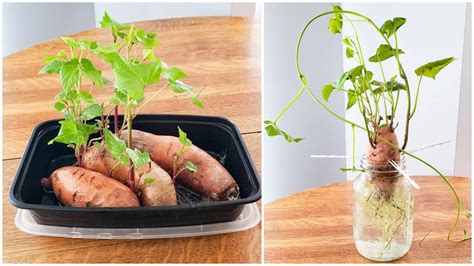Mastering the Art of Growing Sweet Potatoes on Your Balcony
Sweet potatoes are not just a versatile kitchen staple but also a rewarding plant for balcony gardeners. With a bit of creativity, urban gardeners can successfully cultivate this nutrient-rich crop even in small spaces. In this comprehensive guide, we will walk you through essential gardening tips for growing sweet potatoes on your balcony, ensuring outdoor beauty while embracing container gardening methods. Whether you’re a seasoned gardener or a beginner in urban gardening, this guide will help you set up for success.
Key Concepts
- Container Gardening: Using pots, buckets, or planters to grow plants in small spaces, such as a balcony.
- Sweet Potato Slips: The shoots that grow from mature sweet potatoes, used as seedlings for growing new plants.
- Soil Requirements: Sweet potatoes thrive in well-drained, loose, and slightly acidic soil.
- Sunlight Needs: Sweet potatoes need 6-8 hours of direct sunlight daily for optimal growth.
Historical Context
Historically, sweet potatoes have been cultivated in tropical and subtropical regions for thousands of years. Originating from Central and South America, they have spread worldwide due to their adaptability and nutritional value. As urbanization grew, many people believed that gardening was only feasible with large backyards. However, the rise of balcony gardening has challenged that notion, showing that crops like sweet potatoes can flourish even in compact urban environments.
Current State Analysis
Today, container gardening has become popular among urban dwellers, allowing them to enjoy the benefits of fresh produce right from their homes. Sweet potatoes are increasingly favored for balcony gardens because of their adaptability, ease of growth, and minimal space requirements. With the right techniques, even small spaces can yield successful harvests. However, common challenges include managing soil quality, ensuring proper drainage, and optimizing sunlight exposure on balconies.
Practical Applications
For urban gardeners seeking to grow sweet potatoes on their balconies, the following steps provide a clear pathway to success:
- Choosing the Right Container: Use large, deep pots or containers, at least 12 inches deep and wide, to allow enough room for root growth.
- Soil Preparation: Fill the containers with nutrient-rich, well-drained soil mixed with compost. Sweet potatoes prefer slightly acidic pH levels of 5.5 to 6.5.
- Planting Sweet Potato Slips: Purchase or grow your own slips by placing a sweet potato in water and allowing shoots to sprout. Plant the slips 4-5 inches deep in the soil.
- Watering Requirements: Keep the soil consistently moist, but avoid waterlogging. Water once or twice weekly, depending on the weather.
- Sunlight Exposure: Position your containers where they can receive full sunlight for 6-8 hours per day.
- Training Vines: Sweet potato vines can spread out, so consider using a trellis or letting them cascade over the edge of the balcony for aesthetic appeal and to save space.
Case Studies
| Case Study | Challenges | Solutions |
|---|---|---|
| Case Study 1: Small Balcony, Limited Sunlight | Insufficient sunlight due to the north-facing direction of the balcony. | Used reflective materials to direct sunlight toward plants and moved containers to optimize exposure during different parts of the day. |
| Case Study 2: Overwatered Container | Poor drainage leading to root rot. | Switched to a container with better drainage holes and adjusted the watering schedule. |
| Case Study 3: Balcony with High Winds | Plants experiencing stress and damage from strong winds. | Built a wind barrier using lattice or potted plants as a buffer to protect sweet potato vines. |
Stakeholder Analysis
The primary stakeholders in balcony sweet potato gardening include urban gardeners, landlords, and local communities:
- Urban Gardeners: Looking for ways to cultivate nutritious crops within limited spaces.
- Landlords: May need to approve certain modifications, such as trellises or irrigation systems on balconies.
- Local Communities: Promoting sustainable living practices and encouraging gardening as a community-building activity.
Implementation Guidelines
To ensure successful sweet potato cultivation on your balcony, follow these detailed implementation steps:
- Initial Setup: Secure the right containers, soil mix, and sweet potato slips. Prepare your balcony for optimal sunlight and air circulation.
- Regular Monitoring: Check soil moisture regularly and adjust watering schedules based on weather conditions.
- Pest Management: Watch for common pests like aphids or spider mites. Use natural pest control methods like neem oil if necessary.
- End-of-Season Harvesting: After about 90 to 120 days, check if the sweet potatoes are ready for harvest by examining the size of the tubers. Carefully dig them out without damaging them.
Ethical Considerations
From an ethical perspective, balcony gardening reduces carbon footprints by cutting down on food transportation. Growing sweet potatoes, a low-impact crop, supports sustainable agriculture. However, gardeners should be mindful of water usage, especially in regions where water is a limited resource. Additionally, using eco-friendly containers and organic fertilizers contributes to environmentally responsible gardening practices.
Limitations and Future Research
While growing sweet potatoes on a balcony is feasible, it comes with limitations. Space constraints can limit the number of plants, and balconies with poor sunlight may result in smaller yields. Future research could explore advancements in container design, better water management systems for urban settings, and optimizing vertical gardening techniques to further enhance yield. Moreover, innovations in low-light crop breeding may open doors for even more urban gardeners to partake in sweet potato cultivation.
Expert Commentary
In the words of seasoned balcony gardener Laura Richards: “Growing sweet potatoes on my balcony has transformed my view of urban gardening. It’s incredible to see how much you can accomplish with just a few containers and some creativity. The key is to remain adaptable—balcony environments can change quickly, and you need to be prepared to adjust your watering, sun exposure, and even the direction of plant growth to achieve the best results.”


